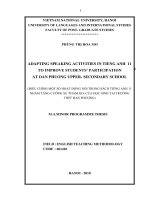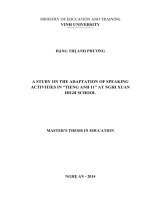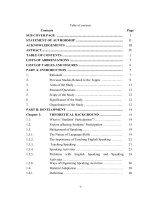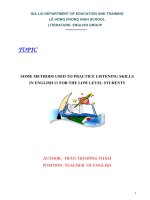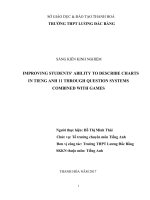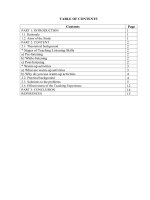Motivationnal activities in post listening in tieng anh 11
Bạn đang xem bản rút gọn của tài liệu. Xem và tải ngay bản đầy đủ của tài liệu tại đây (192.1 KB, 15 trang )
TABLE OF CONTENTS
CONTENTS
PART 1: INTRODUCTION.................................................................
1.1. Rationale.........................................................................................
1.2. Aims of the study............................................................................
PART 2.CONTENT...............................................................................
I.Theoretical background......................................................................
1.Stages of Teaching Listening Skills .................................................
2.What are Post-Listening Activities ...................................................
3.Some of the most common Post-Listening activities are the
following
.....................................................................................
II.SOLUTIONS
...............................................................................
1.The logical basis ................................................................................
2.The practical basis
......................................................................
III. RESEARCH CONTENT ............................................................
IV. Effectiveness of the Teaching Experience .................................
PART 3: CONCLUSION
................................................................
REFERENCE .....................................................................................
PAGE
1
1
1
2
2
2
2
3
4
4
5
5
12
13
14
0
PART 1: INTRODUCTION
1.1. Rationale
Today English is considered one of the most important factors to the
trend of globalization in all fields of life all over the world . Thus , English as
second language has been taught in many countries . As a result, methodology
has been studied for years to find out the most effective ways of teaching and
learning English . In Vietnam, high school students have to acquire four skills
of English as listening, speaking, reading and writing.Of four language skills,
listening has long been considered the most challenging and difficult one by
both foreign language teachers and students. However, the qualities and
effectiveness of teaching and learning this skill are not really as good and high
as expected. From the fact that most EFL teachers at high schools in Thanh Hoa
have faced a lot of problems in teaching listening.
It has been found that although teaching and learning English listening skills
was significant, it was not taken carefully considerations by higher
administrators, educators, teachers and students. In addition, lack of wellequipped facilities, teachers’ unsuitable teaching listening methods, poor
listening methodology and approaches and students’ low level of proficiency,
boredom, indifference as well as de-motivation are obstacles in most high
schools in Thanh Hoa. Many students claimed that they felt tired of listening to
the tape from beginning to the end with controlled exercises in the textbook.
Without interest, motivation and variation in teaching and learning students
found it hard to study in listening class. So it is necessary for teachers to realize
the importance of how to make listening classes more interesting and to know
how to motivate students so that they can make progress in listening
comprehension.
Having researched this topic, I hope to improve some problem of
teachinglistening skill including Post listening part more effective ly. The
students will be able to obtain the knowledge better when learning how to
listen. I hope thart the topic “Suggested some activities in Post- Listening of
Grade 11” – the basic pogramme will be more interesting in order to attract
students’ excitement during listening period. That is the reason why I choose
the topic.
1.2. Aims of the Study
The aims of the study are as follows:
- To investigate EFL teachers' problems in creating a good lead-in of a
listening lesson in "Tieng Anh 11".
- To suggest some activities in Post – Listening part in “Tieng Anh 11”.
1
PART 2: CONTENT
I.Theoretical background
1.Stages of Teaching Listening Skills
Teaching listening text can be divided into three main stages: pre-listening,
while-listening and post-listening. Each stage has its own aims and activities.
a) Pre-listening
Pre-listening stage aims at preparing students with everything necessary for
listening and understanding the listening text. This stage is of great importance
since it leads students to the listening passage that they are going to listen,
arouses their interests and provides students with the purposes of listening as
well as the input before they listen.
Some activities at this stage are:
❖ Warming up the class:
The teacher may motivate the class, gradually set up a context for listening text
to be presented by asking questions to elicit students’ experience, or ideas
concerning the coming text or by using some sort of visual aids or their
imagination.
❖ Introducing the topic of listening text:
The teacher briefly introduces the topic of listening text so that the students may
get their mind already for it.
❖ Presenting key words:
The teacher only presents any word that is necessary for students to understand
the text.
❖ Giving guiding questions:
These guiding questions will help focus the students’ attention on the main
points of the text. They will guide the students to the better understanding of the
text. Students should be allowed to make guesses at the answer to the questions
before listening.
These activities may give students a chance to get some knowledge which helps
them to follow the listening text. Therefore, when choosing an activity, the
teacher should consider factors that Underwood (1989) states: The time, the
material is available or not, the interests of the class and the teacher, the place
where the work is being carried out, the nature and the content of the listening
text itself. If one of these factors is ignored, the whole process of the activity
can be failed.
b) While-listening
The aim of this stage is to facilitate students’ listening and check their
comprehension. While the students are listening to the text for the first time,
they can check their guess and give the correct answer to the guiding questions.
Then the teacher gives the students some tasks to do while they are listening for
the second time. They can do some of the activities such as: gap-filling, true or
false statements, answering comprehension questions, matching, multiple
choice, reordering, etc. While-listening stage gives students a guide to practice
2
listening because they need a reason to listen which helps them to focus their
attention. As Rixon (1986) mentions, the purpose of while-listening stage is to
challenge and guide students to master the information and the message from
the passage. To facilitate students’ comprehension, the teacher should provide
useful techniques such as clear instructions, playing tapes on purposes,
classifying levels of difficulty of task from easier to more difficult, and so on.
It is advisable that while-listening activities should meet students’ different
levels and needs so that they are encouraged to listen better.
c) Post-listening
At this stage, students can have opportunities to practice using what they have
got from the listening text. Post-listening activities are performed after the
listening is finished. According to Underwood (1989), the first purpose of those
activities is to check how well the students understood and whether they have
finished the listening task. The second one is to reflect on why some students
have failed to understand or miss parts of the passage. Moreover, post-listening
activities aims at expanding the topic or the language of the listening text.
Students are also given an opportunity to consider the attitude of the speaker in
the listening text because they can realize the purpose of the speaker based on
his/her attitude.
Students can do some following activities:
❖ Summarizing the text orally or in written form
❖ Re-telling the content of the listening text
❖ Role-play:
Students play the roles of the characters in the text.
❖ Discussion:
The teacher should make up and vary the activities for students to do at
this stage depending on their level of English. In addition, the teacher should
pay more attention to the following factors in selecting post-listening activities:
▪
The amount of language work the teacher desires to do related to the
listening text
▪
The time limitation
▪
Speaking, reading and listening skills should be integrated in postlistening activities
▪
Pair work and group work should be encouraged
▪
The designed activity should be motivating to students
2.What are Post-Listening Activities
Post-Listening Activities consist of tasks which main aim is to help students
reflect on the listening experience. these activities are carried out after teacher
have carried out pre-listening and while listening activities successfully.
3.Some of the most common Post-Listening activities are the following:
3
3.1. Check and Summarizing: One of the activities that a teacher can do to
check understanding is to ask student to summarize the information they heard,
this can be done orally or in writing.
3.2. Discussions: You can ask students to have a short discussion about the
topic, the topic for the discussion must be taken from the listening task that they
previously did and should be interesting enough to inspire comments and
debates.
3.3. Information Exchange: In this activity you ask students to listen to a
passage and ask another to listen to a different passage, when they finish, they
share they information with each other and make sure that they understand the
message the passage was intended to give.
3.4. Problem Solving: Students listen to a passage with the intention of solving
a problems Some problem-solving task types such as solving moral dilemmas
and solving mysteries will motivate students to listen carefully to a passage.
3.5: Deconstructing a Listening Passage: Most books have transcripts at the
back of the books, those transcripts are often unused but you can use them to
exploit features such as pronunciation, vocabulary, grammar and discourse
markers.
3.6: Disappearing Dialogues: Another activity students can do to promote
critical thinking skills is erasing parts of the dialogue and then asking students
to fill in the blanks with phrases they remember or other phrases that might fit
perfectly into the dialogue.
3.7: Test your Classmates: You can ask students to prepare a set of questions
that another student will have to respond, they can prepare a multiple-choice
quiz, short answer questions or true and false statements.
3.8: Writing a short composition: After students have listened to a passage,
they can write a short essay based on the information given in the listening
passage.
3.9: Time to Act: After listening to a passage, students can identify a theme and
create a skit and perform it in front of their classmates.
3.10: Synonyms and Antonyms: Another activity that students can do is
identifying vocabulary and then find synonyms and antonyms for some words
in the transcript.
II.SOLUTIONS
1.The logical basis:
Having spent much time teaching listening skill, T personally think that the
aim of teaching listening is to develop listening comprehension skills for
students such as intensive listening, extensive listening, listening and making
predictions.... Therefore, in this part, I have tried to design some activities in
Post - listening of Grade 11. They are Questions and Answers, Gap-Filling,
Role play, Discussion,Games, Retell the story, etc...
Post- Listening is the last procedure of listening lesson, which lasts about
maximum of from five to ten minutes. They help students achieve activeness
4
and pleasure after listening.. The students do not depend on the tape scripts.
After “ While Listening”, students are able to recall students the story or further
practice. It is this step that help them improve their listening skill.
2.The practical basis:
When teaching listening skill, I realise that most students are not interested in
listening. As they are not able to listen , they are bored with this skill. They
can only read the tape scripts in the guide book to answer the Tasks in the
texbook.
From the practical problem, I think I must redesign some activities of “ Post
– Listening “ in order to improve students’listening comprehension better .
These tasks are up to students’level for each class. In order to have effective
listening lesson, there is the cooperation between teacher and students.
The lesson at class:
- The teacher divedes class into pairs that is suitable for each activity of the
lesson. The teacher can use pictures , handouts, posters to practise .
- Correction is an necessary part of the lesson. I think the teacher has to be
sensitive and positive to correct the students’ answers. Correction techniques
are used to encourage students and not to put them down and terrified . The
teacher should get the main idea and he does not pay attention to the detailed
mistakes of students.
III. RESEARCH CONTENT
Having taught listening skill in English Grade 11 many years, I have
designed some activities in Post- Listening for the following lessons unit 1,
unit 2, unit 3, unit 4, unit 6, unit 7, unit 8, unit 9, unit 10, unit 11, unit 12, unit
13, unit 15 and unit 16.
UNIT 1: FRIEND SHIP
Work in groups:
- Plus good mark if individuals, pairs or groups do well to encourage them
and to create excitement in studying.
2.3.Solutions to these problems:
UNIT 1: FRIENDSHIP
1. Activity 1:
-T. asks ss to make questions and then answer about Lan and Long’s best
friend. (T. gives the cues)
1. Where / Ha and Lan/ used to/ live?
2. How long / they/ be /friends?
3. How / Ha?
4. Where / Long and Minh/ meet?
5. Long/ a singer?
6. What / Minh’s good quality?
Report:Long best friend's is Minh. He lives in Hanoi now.He is very friendly,
helpful and sociable. They used to live in the same residential areas in Halong.
5
Long went on a three-day trip to Halong and they met there.They have become
friends since that trip.
UNIT 2. PERSONAL EXPERIENCES
Work in groups:
Complete the Paul’s story mindmap below basing on the listening
Where it
happened
.........................
When it happened
......................
The most unforgetable
experienced of Paul
How the
experience
affected her......
How it happened
......................
Report: The most unforgetable experience of Paul happened 3 years ago. He
forgot to turn off the gas stove in the kitchen.When the fire started, he was
sleeping. He was terrified. Luckily, his mother came and rescued him. The
experience made him appreciate his family more than things.
UNIT 3. A PARTY
Divide the class into small groups and ask the Ss to talk about Mai’s birthday
party using the answers.
1.Where was the party held?
2.When did it began/ ended?
3. How many gue ss are there
4.What did you do there?
5.What did Mai do in the party?
6. Where were you after the party
1. It was held in Mai’ shouse
2. It began at 7p.m and ededed at9p.m
3. 20 guess came
4. Clapped, sang , played cards
5. Opened the gifts, cut cake ...
6. Walked home.
UNIT 4. VOLUNTEEER WORK
6
Work in group to complete the mindmap about the Spring school then report it
Aim:........................
Spring school
The number of the children:........
Kinds of volunteers:...................
Activities the children take part in:......................
Teacher divides class into groups of three or 4 to sumarize the story Spring
School, using the suggested questions above.
Possible answers:
- Aim: to help organise their fundraising dinner held annually in June
- 30 street children
- Street children and children special difficulties
- Dance, theatre, singing and folk music
Report: Spring school provides to disvantaged children in Ho Chi Minh city.
The number of children attending classes regularly is 250 children and 30
children living and studying at school . Children take part in dancing, singing
and playing music at school. Now they need foreign volunteers.
UNIT 6. COMPETITION
Activity:
Complete the table below basing on the listening
Boston Marathon
Years/ numbers
Events
Boston marathon began
John Mc Demott won the first
Boston Althletic
50minutes 10 seconds
1967
Kuscsick became the first female
champion
6164 runners took part in
Report : Boston Marathon began in 1897. And John Mc Dermott won the
first Boston Althletic Association marathon. His score is 50 minutes 10
seconds . In 1967. Kuscsick became the first female champion. There were
6164 runners who took part in the Boston marathon .
7
UNIT 7. WORLD POPULATION
Activity:
Work in groups. Complete the table below basing on listening.
Causes
Consequences
Ovepopulatio
n
Facts and figures
Solutions
Suggested answers:
- raise an awareness of the problems of overpopulation
- raise the the people’s living standard
- exercise/implement reward and punishment policy
- carry out population education program/family planning program
- use birth control methods
Ss talk about the problem of overpopulation and offer solutions
UNIT 9: THE POST OFFICE
Acticity: Work in groups to complete the numbers or years
93
1996
2nd
30
2000
1. Vietnam ranks...............for growth in he number of telephone subcribers
2. Vietnam is among the......................countries in the world that have more
than two million telephone.
3. In........., Vietnam began upgrading its fix telephone networks and
changing numbers from 6 to 7
4. Since ................., there has been the reduction in monthly telephone fees
5. At present,................... percent of communes across Vietnam have
telephone services.
- Procedure: teacher divides class into 4 groups.
- Guide them to listen
8
- Play the tape 2-3
-Ask students to do the task
- After check them to answer
UNIT10 :NATURE IN DANGER
Game: Animal Guessing
- Prepare an audio-tape with various sounds of animals such as monkey, lion,
snake, pig, etc.
- Divide the class into 2 groups: Group A and group B
- Play the tape for Ss to listen to the sound one by one. The group that gives the
correct answer first will get 1 mark. If not, they have no marks and the other
group will take the turn to answer. At the end, the group with more points will
be the winner.
- Organize the game and score the marks of each group.
- Declare the winner.
UNIT 11. SOURCES OF ENERGY
Divide students into 4 groups. The teacher asks them to discuss in group
and decide which group the given sources of energy belong to by putting a
tick in the right column.
- Organize the game and score each group’s points.
- Declare the winner.
Sources of energy
Coal
Geothermal heat
Petroleum
Solar energy
Oil
Nonrenewable
Renewable
UNIT 12: THE ASIAN GAMES
Game: Role play
- Divide Ss into Student A (interviewer) and Student B (athlete).
- T delivers the cards for Ss.
- Ask Ss to make an interview about: the result, the preparation, the feeling after
setting a new record or failing a competition
Example:
A: Would you mind if I asked you some questions?
B: You’re welcome.
9
A: Are you pleased with your record?
B: Oh, of course because I’ve just set a new record.
A: Really? Congratulation! What was the new one?
B: Only 1 minute and 30 seconds.
A: Great! You must prepare a lot for this competition.
B: Yes, I spent lots of time practicing.
A: How do you feel now? Happy?
B: Extremely excited.
A: Once again congratulation. Thank you.
- Let Ss have 3 mins to prepare and then call out.
UNIT 13: HOBBIES
Work with a partner. Talk about the disadvantages of over-reading reading
too much
Suggested answers
1.Some disadvantages of over-reading
2.Becoming shortsighted
3.Not having enough physical exercise
4.Lacking practical knowledge
5.Becoming a bookworm/ overweight
Report:
I love reading, but over-reading has its downsides. First and foremost,
people who read too much are prone to become shortsighted because their eyes
are not relaxed after many hours of reading. Secondly, the time spent on reading
is so much that they don’t have enough physical exercise, which makes them
overweight and unhealthy. Last but not least, reading means that they just sit at
home seeing what other people have done so they don’t have the real
experiences and seriously lack practical knowledge. In conclusion, reading is
good if you have a balanced timetable between books and the real life.
UNIT 15. SPACE CONQUEST
Discussion.
Discuss the following questions.
1. In your opinion, what is the reason for the human interest in Mars and other
planets in the solar system?
2. If you were offered a chance of going to the moon and you could take three
things with you, what would you choose and why?
Suggested answer:
1. I think human beings like adventure.
10
2. I would take a camera to take a lot of photos, water to drink and a Vietnam
flag as a reminder for a Vietnamese person's appearance.
UNIT16. THE WONDER OF THE WORLD
Activity 1:
Game: Sing these numbers to the teacher asks students to use
number to talk about the Great Wall Of China.
With this task, students can use their own words to present
their ideas.
- If the teacher has more time, he/ she has students watch
video clips of the wonders of the world in order to broaden
students’ knowledge.
Watch the video clip of the wonders of the world
( please watch the video clip attached in disc)
1385
200years
The Great
World
6000
1987
5
Key: The Great wall of China winds up and down across deserts, grasslands
and mountains of 5 provinces. In 1987 the Great Wall was listed as a World
Heritage by UNESCO. It started to be built in 1368 and took 200 years to
complete. It stretches for about 6,000 km from east to west. The wall is about
11 metres high. The Great wall is a symbol of the Chinese nation throughout
history.
Activity 2. Discussion :Work in groups.
11
Tell your partners why the Great Wall is considered one of the greatest wonders
in the world and how it was built.
A: Why is the Great Wall considered one of the greatest wonders in the world?
B: Because it takes very, very long time to complete, about 200 year.
C: And it is said to be visible from the moon and down across deserts,
grasslands and mountains of 5 provinces. It stretches for about 6,000km from
east to west.
A: How was it built?
D: It was made of stone, brick, tamped earth, wood, and other material
IV. Effectiveness of the Teaching Experience
Having done the researh , I myself find the activities in Post- Listening
has the result :
Students’listening skill and response have been improvd considerately. The
students have used some information in Listening lessons into speaking and
Writing skill. Therefore, their speaking and writing skills are also improved.
The students who are weak and average level are more interested in learning
English. They are more confident and volunteer to answer and do the tasks.
These suggested activities have been applied in my listening teaching to 11 th
students at my school. I believe that they seem to be useful to students. This
was shown through their high motivation and interest in learning listening, their
active participation in activities and then many students at low levels could
carry out listening tasks by themselves.These activities help them to have
something related to the listening topic in their mind before going to listen to.
As a result, students’ listening skills, to some extent, have been improved
during the school years. That also proved that students always wanted their
teacher to motivate them by organizing interesting activities and creating
comfortable learning atmosphere.
From the results above, it might be said that post - listening activities can
bring students out of boredom and support them to learn better . These
activities enable students to learn from each other and make them feel more
confident to give out their answers .
12
PART 3: CONCLUSION
In conclusion, I strongly believe that all of the activities mentioned
above for Post- listening such as discussion , games, guessing role- play , find
some who... do help student have deeper understanding of the listening
lessons. By using these above activities , teachers can provide students with
opportunities to foster what they have learnt . These activities can also make
a contribution to the success of he listening lessons in which there is
requirement of students individual roles or responsibilities in the language
class. After trying to apply the adaptation techniques to design Poast- listening
activities for listening lessons at upper-secondary school with the participants of
11th grader, it seems that my students are more eager to study listening skill.
The adaptation and creation of warm-up listening activities in an easier and
more familiar with their real life makes the students more confident in carrying
out listening requirements followed because, to some extent, they have
background knowledge to listen about. However, many of these activities can
be modified and used as regular classroom activities. It can be easily prepared
and enhance the students’ motivation before class.
In my final analysis, these post-listening activities would give a good
solution , to the promlems in the process of teaching listening.
XÁC NHẬN CỦA THỦ
TRƯỞNG ĐƠN VI
Thanh Hóa, ngày 25 tháng 05 năm 2019
Tôi xin cam đoan đây là SKKN của mình
viết, không sao chép nội dung của người
khác
Người viết
Nguyễn Thị Thúy
13
REFERENCES
English Authors:
1.Doff, A. 1988. Teach English: A Training Course for
Teachers. Cambridge University Press
2. Brown, H. D. (1994), Teaching by Principles, New Jersey: Prentice Hall
Regents.
3.Rost , M.1994. Introducing listening, London: Penguin.
4.Rixon, S. (1986), Developing Listening Skills, London and Basingstoke:
Macmillan.
5.Lee, S.K. (1995). Creative games for the language class.
“Forum”, 33(1), pg.
B. Vietnamese Authors:
6.Tiếng Anh 11 ( Hoàng Văn Vân, Hoàng Thị Xuân Hoa, Đỗ Tuấn Minh ,
Nguyễn Thu Phương, Nguyễn Quốc Tuấn), Nhà xuất bản giáo dục.
7.Thiết kế bài giảng Tiếng Anh 11 ( Chu Quang Bình )- Nhà xuất bản Hà Nội
8. Giới thiệu giáo án Tiếng Anh 11 ( Vũ Thị Lợi , Nguyễn Hải Châu, Đồng Thị
Yến Trang, Nguyễn Thị Ý, Võ Thị Minh Hồng ) – Nhà xuất bản Hà Nội
9. Hướng dẫn thực hiện chuẩn kiến thức , kĩ năng, môn Tiếng Anh THPT_ Nhà
xuất bản giáo dục Việt Nam.
C. Additional Reference:
Website:
Website:
14

